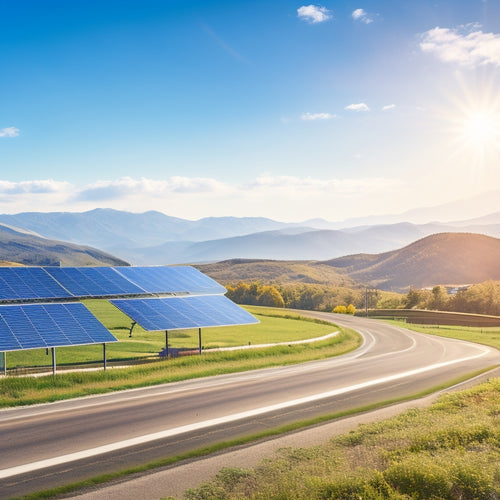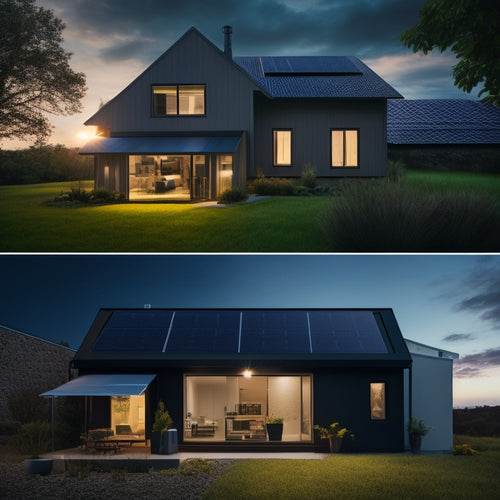
Solar Panels for Your Home
Share
You're considering installing solar panels on your home to utilize the power of the sun and shift to a cleaner, more sustainable energy source. By doing so, you'll reduce your carbon footprint and lower your emissions, contributing to a healthier environment. You'll also save money on your energy bills, as solar power decreases your reliance on the grid. When selecting solar panels, look for efficient energy harvesting cells with high conversion rates to maximize your energy output. Before installation, assess your roof's shading and adjust the panel layout accordingly. Next, you'll want to investigate the finer details of energy conversion and output maximization to get the most out of your investment.
The Essentials
- Switching to solar energy provides a clean, renewable power source, reducing your carbon footprint and contributing to climate change mitigation.
- Solar panels can save you money on your energy bills, with financial incentives like tax credits and rebates offsetting installation costs.
- When selecting solar panels, consider efficient energy harvesting cells with higher conversion rates to maximize energy output and optimize performance.
- Roof shading considerations, such as evaluating obstructions and angles, are crucial for optimal solar panel placement and energy collection.
- Regular maintenance, monitoring, and seasonal adjustments can help sustain optimal energy output and ensure the longevity of your solar panel system.
Reduce Carbon Footprint Now
You can greatly reduce your carbon footprint by switching to solar energy, which is a clean and renewable source of power.
By investing in a solar generating system, you can utilize the sun's energy and reduce your dependence on traditional power sources, resulting in lower utility bills.
By going green today, you'll lower emissions now, contributing less to climate change and air pollution.
In doing so, you'll not only help the environment but also set a positive example for your community.
Go Green Today
Embracing a sustainable lifestyle has become increasingly vital in the current era, where climate change and environmental degradation pose considerable threats to our planet's well-being.
You can take an important step towards reducing your carbon footprint by adopting eco-friendly practices in your daily life. One effective way to do this is by utilizing Renewable Energy Solutions and investing in solar panel systems, which can markedly reduce your reliance on grid electricity and lower your energy bills.
Start by reducing your energy consumption, reusing and recycling, and using public transport or carpooling.
You can also incorporate sustainable living habits, such as using energy-efficient appliances, turning off lights and electronics when not in use, and using eco-friendly cleaning products.
Lower Emissions Now
By incorporating renewable energy sources into your daily life, you're taking an important step towards reducing your carbon footprint.
One of the most effective ways to do this is by installing solar panels on your home. Solar energy is a clean and sustainable renewable resource that greatly lowers your reliance on fossil fuels, thereby reducing your environmental impact.
With solar panels, you'll be generating electricity from sunlight, a free and abundant resource, instead of burning coal or natural gas. This switch not only reduces greenhouse gas emissions but also decreases air pollution, conserves water, and mitigates climate change.
By utilizing Renewable Energy Solutions, you'll be able to break free from reliance on the grid and reduce your electricity bills, while also providing backup power during outages and emergencies.
By choosing solar power, you're directly contributing to a cleaner, healthier environment for yourself and future generations.
As you lower your emissions, you'll also enjoy the freedom from rising energy costs and the satisfaction of being part of the renewable energy revolution.
Save Money on Bills
You can greatly lower your expenses by switching to solar power, as it reduces your reliance on the grid and decreases your energy costs.
By adopting renewable energy solutions, you can also contribute to a more sustainable future.
With solar panels, you'll generate free energy during the day, which translates to savings on your electricity bills.
Lower Your Expenses
Reducing your reliance on the grid can lead to significant savings on your energy bills. By installing solar panels, you'll generate your own clean energy, reducing your dependence on traditional power sources. This means you'll pay less for electricity, and those savings will add up over time.
When you invest in solar panels, you'll benefit from financial incentives like tax credits and rebates. These perks can help offset the initial installation costs, making the shift to solar more affordable.
Additionally, many states and utilities offer net metering programs, which allow you to sell excess energy back to the grid and offset your energy consumption.
Reduce Energy Costs
Most homeowners can expect to save hundreds of dollars annually on their energy bills after installing solar panels. This significant reduction in energy costs is a major advantage of going solar.
With solar incentives and tax credits, you can offset the initial installation costs and start saving money sooner. Financing options are also available to help you cover the upfront costs. Once installed, your solar panels require minimal maintenance, ensuring long-term savings.
Additionally, you'll enjoy energy independence, relying less on the grid and its unpredictable prices. With technology advancements, solar panels are becoming more efficient, increasing your energy production and savings.
You can even consider DIY installations, although professional installation is recommended for peak performance and grid connection. By switching to solar, you'll not only reduce your energy bills but also contribute to a cleaner environment.
With the right financing and installation, you can start enjoying the financial benefits of solar energy and take a significant step towards energy freedom.
Efficient Energy Harvesting Cells
When selecting solar panels for your home, you'll want to take into account the cell efficiency ratings, which measure how well the panels convert sunlight into electricity.
Higher efficiency ratings translate to more power output per unit area, making them ideal for smaller roofs or those with limited space.
With top-rated high-efficiency residential solar panels, you can boost your home's energy and maximize energy savings.
Cell Efficiency Ratings
With solar panels, the efficiency of the photovoltaic cells is vital in determining the overall energy output of your system. You'll want to take into account cell efficiency ratings when selecting the right solar panels for your home.
There are two primary cell types: monocrystalline and polycrystalline. Monocrystalline cells have higher efficiency ratings, typically between 15-20%, while polycrystalline cells have lower ratings, around 12-15%.
When comparing performance, bear in mind the installation technique, as it can impact energy output. For example, bifacial panels can increase energy production by up to 25%.
Regular maintenance, such as cleaning, is also significant to guarantee peak performance. Be mindful of the environmental impact, as higher-efficiency cells often require more energy to manufacture.
Warranty considerations are also important, as they can vary depending on the manufacturer. Stay informed about market trends and technological advancements, as they can improve efficiency and reduce costs.
Power Output Optimization
Through careful selection of solar panels, you can maximize energy collection by enhancing power output. This involves considering various factors that impact the performance of your solar panel system.
One vital aspect is panel orientation. By positioning your panels at an ideal angle, you can increase energy production. For instance, if you live in the northern hemisphere, a south-facing orientation is perfect.
Seasonal adjustments are also important for maximizing power output. As the sun's angle changes throughout the year, adjusting your panel's tilt can guarantee you're utilizing the most energy possible. During winter, a steeper angle can help capture more sunlight, while a shallower angle is better suited for summer.
Additionally, you should consider the type of solar panels you're using. Look for panels with high efficiency ratings and a low temperature coefficient, as these will perform better in hot temperatures.
Assess Your Roof's Shading
When evaluating your roof's shading, you'll need to take into account obstructions that can cast shadows on your solar panels, such as chimneys, vents, and skylights.
For flat roof installations, it's crucial to safely and securely attach solar panels using solar panel mounting systems to minimize damage risk.
You'll also need to identify areas of your roof that receive partial or full shade, especially during peak sun hours.
Roof Obstructions to Consider
Evaluating your roof's shading is crucial to determining the ideal placement of solar panels, as obstructions can markedly impact energy production.
You'll want to examine your roof's angles and identify potential obstructions, such as skylights, vents, and chimneys, which can cast shadows and reduce energy output. Installation challenges can arise when dealing with complex rooflines, multiple roof angles, and irregularly shaped roofs.
When evaluating your roof, consider the orientation and pitch of each section. South-facing roofs with a pitch between 15 and 40 degrees are ideal for solar panels, as they receive the most direct sunlight.
However, if your roof has multiple angles or is partially shaded, you may need to adjust the panel layout or consider using microinverters to optimize energy production.
Be aware of local building codes and regulations that may impact your installation. By carefully examining your roof's obstructions and angles, you can guarantee a successful and efficient solar panel installation.
Identify Shaded Areas
Your roof's shading pattern plays an essential role in determining the suitability of a solar panel installation. When evaluating your roof's shading, you'll need to identify areas that receive partial or full shade throughout the day. This is vital because shaded areas can greatly reduce the energy output of your solar panels.
To conduct a shading analysis, observe your roof during different times of the day and year. Note the areas that receive direct sunlight exposure and those that are partially or fully shaded. Reflect on the impact of surrounding trees, buildings, and roof obstructions on sunlight exposure. You can also use online tools or consult with a solar panel professional to help you with this evaluation.
Identify the times of day and year when shading is most prevalent. For instance, if a tree casts a shadow on your roof during the winter months, but not during the summer, you may need to think about trimming or removing the tree to maximize sunlight exposure.
Higher Energy Conversion Rate
When selecting solar panels for your home, you'll want to prioritize those with a higher energy conversion rate to maximize energy output.
This rate, typically expressed as a percentage, indicates how efficiently the panels convert sunlight into electricity.
Maximizing Energy Output
To maximize energy output from your solar panels, it's essential to optimize their performance by increasing the energy conversion rate. This can be achieved by strategically placing your solar panels to capture the most sunlight.
Proper solar panel placement involves orienting them at an angle that allows them to receive direct sunlight for the longest period possible. Additionally, placing them in a location with minimal shading and obstructions will guarantee maximum energy output.
Another key factor in maximizing energy output is the use of advanced inverter technology. Inverters convert the DC power generated by your solar panels into usable AC power for your home.
High-efficiency inverters can greatly increase the amount of energy produced by your solar panels. Look for inverters with high conversion rates and features like maximum power point tracking (MPPT) to assure you're getting the most out of your solar panels.
Frequently Asked Questions
Can Solar Panels Be Installed on Old or Historic Homes?
When restoring a historic home, you'll need to balance preservation with modernity, considering historic home considerations that impact solar panel aesthetics, ensuring a seamless blend of old and new while maintaining the original charm.
How Do Solar Panels Perform During Power Outages?
When the grid goes down, you'll be glad to know that your solar panels won't provide power - unless you've got a backup battery system. In that case, you'll maintain solar panel efficiency and enjoy uninterrupted electricity, free from the grid's constraints.
Are Solar Panels Prone to Theft or Vandalism?
You're wise to contemplate the risk of theft or vandalism; fortunately, you can mitigate it with insurance coverage and strong security measures, such as tamper-evident devices and surveillance systems, to safeguard your investment.
Can I Install Solar Panels Myself to Save Money?
A million DIY projects can't prepare you for the complexity of solar panel installation; while you'll save on labor costs, improper installation can void warranties and compromise efficiency, offsetting potential cost savings.
Do Solar Panels Require Frequent Cleaning or Maintenance?
You'll need to clean your solar panels periodically to guarantee maximum energy output, but the frequency depends on your location and climate; follow maintenance tips like hosing them down every 6-12 months to keep them running efficiently.
Final Thoughts
You've made a smart choice by considering solar panels for your home. By capturing the sun's energy, you'll greatly "greenify" your lifestyle, reducing your carbon footprint and saving money on bills. With efficient energy collection cells, you'll enjoy a higher energy conversion rate. Before installation, assess your roof's shading to optimize panel placement. Now, take the first step towards a sustainable future - and a healthier planet.
Related Posts
-

Is Switching to Green Energy Solutions Easy
Switching to green energy solutions isn't just easy; it's also beneficial. You can greatly cut utility costs and enjo...
-

Solar Powered Lights for Sustainable Home Decor
Solar-powered lights offer a stylish and eco-friendly way to enhance your home decor. They capture sunlight, converti...
-

Cost of Home Solar Battery
You're looking to invest in a home solar battery to reduce your grid reliance, but you're curious about the cost. The...


